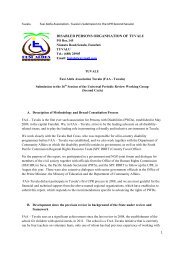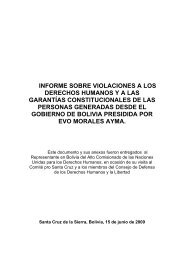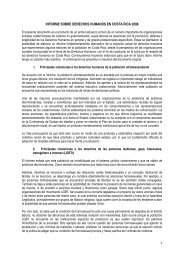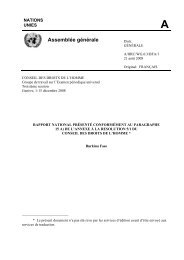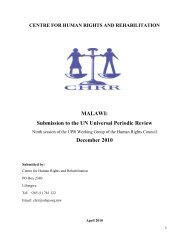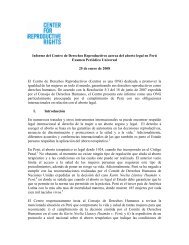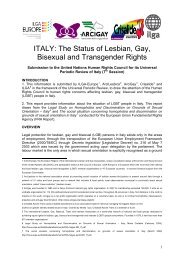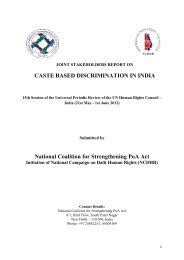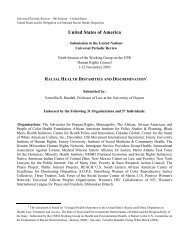Prison Needle Exchange: Lessons from a Comprehensive Review ...
Prison Needle Exchange: Lessons from a Comprehensive Review ...
Prison Needle Exchange: Lessons from a Comprehensive Review ...
Create successful ePaper yourself
Turn your PDF publications into a flip-book with our unique Google optimized e-Paper software.
staff, is also an indication of the importance of confidentiality to the program’s users.<br />
Similarly, the evaluation of the two German pilots found that the program that used a handto-hand<br />
distribution method through health-care staff enjoyed less trust <strong>from</strong> prisoners than<br />
did the one using anonymous dispensing machines.<br />
That said, the Bilbao project also indicated that absolute anonymity is perhaps less important<br />
to the people who inject drugs than is trust in the person(s) or agency running the program<br />
and the quality of the service provided. The Bilbao evaluation found that the prisoners<br />
valued the personal interaction with workers <strong>from</strong> an external non-governmental organization<br />
who conducted the exchanges, and in fact identified this as a preferable distribution<br />
method than anonymous dispensing machines.<br />
Adequate access to needles<br />
In addition to maximizing confidentiality, providing adequate access to the needle exchange<br />
program has also been a key factor in ensuring that programs meet prisoner needs. In some<br />
cases, this has been accomplished by the placement of multiple dispensing machines within<br />
a single institution, as was the case in the Hindelbank pilot. When person-to-person methods<br />
of distribution have been chosen, such as in the Lingen 1 Dept Groß-Hesepe pilot in<br />
Germany or the Bilbao pilot in the Basque region, staff sought to identify areas of the prison<br />
that were both discreet and easily accessible to prisoners. In the Moldovan experience, the<br />
decision to use a peer-based structure allowed for 24-hour access, since the peer outreach<br />
workers lived in the prison units where they distributed needles.<br />
<strong>Needle</strong> exchange as part of a harm-reduction program<br />
It has also been shown that the goal of reducing HIV and HCV transmission is best accomplished<br />
when prison needle exchange is one component of a broader, comprehensive harmreduction<br />
strategy. In prisons in all six countries studied for this<br />
report, prison needle exchange programs are part of larger harmreduction<br />
initiatives. Other harm-reduction measures provided to<br />
prisoners include HIV/HCV education, substitution therapy for<br />
drug treatment, condom distribution, distribution of bleach or other<br />
disinfectant, antiseptic wipes, razors for shaving, and anonymous<br />
HIV and HCV testing. Although the issue has not been scientifically<br />
evaluated, <strong>from</strong> the primary evidence and experience presented in<br />
this report it appears that prison needle exchange programs and<br />
other harm-reduction measures are mutually reinforcing, and that<br />
the (prior) existence of other harm-reduction measures has contributed<br />
to the successful implementation of needle exchange programs.<br />
In some prisons, this comprehensive harm-reduction approach includes not screening for<br />
THC (the active ingredient in cannabis) as part of urinalysis drug-testing programs used in<br />
the prison. A number of prisons visited as part of this report have made the decision not to<br />
screen for THC, or not to penalize for the presence of THC, as they believe that doing so<br />
would encourage many prisoners to abandon cannabis use in favour of injecting drugs to<br />
avoid detection.<br />
Importance of evidenced-based decision-making:<br />
evaluating pilot projects<br />
The goal of reducing HIV<br />
and HCV transmission is<br />
best accomplished when<br />
prison needle exchange is<br />
one component of a<br />
broader, comprehensive<br />
harm-reduction strategy.<br />
One final common aspect is the use of a well-evaluated pilot project as a first step to expansion.<br />
In some countries a single pilot has been used, while others such as Germany imple-<br />
Analysis of the Evidence 55



